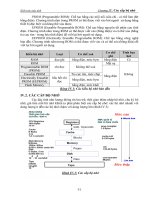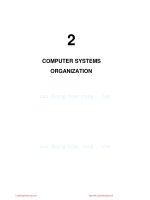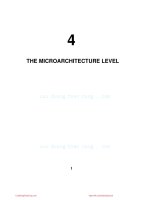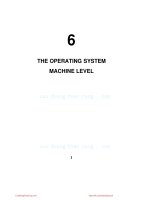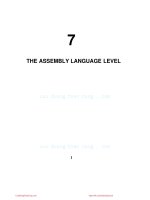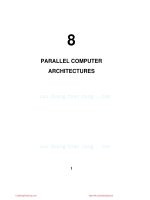kiến trúc máy tính dạng thanh tin figs 5 the instruction set architecture level sinhvienzone com
Bạn đang xem bản rút gọn của tài liệu. Xem và tải ngay bản đầy đủ của tài liệu tại đây (165.85 KB, 52 trang )
5
THE INSTRUCTION SET
ARCHITECTURE LEVEL
1
CuuDuongThanCong.com
/>
FORTRAN 90
program
C program
FORTRAN 90
program compiled
to ISA program
C program
compiled
to ISA program
Software
ISA level
Hardware
ISA program executed
by microprogram or hardware
Hardware
Figure 5-1. The ISA level is the interface between the compilers and the hardware.
CuuDuongThanCong.com
/>
Address
Address
8 Bytes
15
14
13
12
11
8 Bytes
10
9
8
24
16
8
0
19
15
14
13
17
16
12
Aligned 8-byte
word at address 8
(a)
18
Nonaligned 8-byte
word at address 12
(b)
Figure 5-2. An 8-byte word in a little-endian memory. (a)
Aligned. (b) Not aligned. Some machines require that words in
memory be aligned.
CuuDuongThanCong.com
24
16
8
0
/>
Bits
16
8
AH
BH
CH
DH
8
A X
B X
C X
D X
AL
EAX
BL
EBX
CL
ECX
DL
EDX
ESI
EDI
EBP
ESP
CS
SS
DS
ES
FS
GS
EIP
EFLAGS
Figure 5-3. The Pentium II’s primary registers.
CuuDuongThanCong.com
/>
Register
R0
R1 – R7
R8 – R13
R14
R15
R16 – R23
R24 – R29
R30
R31
Alt. name
G0
G1 – G7
O0 – O5
SP
O7
L0 – L7
I0 – I5
FP
I7
Function
Hardwired to 0. Stores into it are just ignored.
Holds global variables
Holds parameters to the procedure being called
Stack pointer
Scratch register
Holds local variables for the current procedure
Holds incoming parameters
Pointer to the base of the current stack frame
Holds return address for the current procedure
Figure 5-4. The UltraSPARC II’s general registers.
CuuDuongThanCong.com
/>
R0
R1
G0
G1
0
Global 1
G0
G1
Global 7
R7
G7
R8
O0
0
Global 1
…
…
…
G7
…
…
…
R7
R0
R1
Global 7
CWP = 6
…
…
Alternative name
R13
R14
R15
O5
SP
O7
Stack pointer
Temporary
R16
L0
Local 0
…
…
…
CWP = 7
R8
O0
Outgoing parmeter 0
Local 7
R24
I0
Incoming parameter 0
Outgoing parmeter 5
Stack pointer
Temporary
R16
L0
Local 0
…
…
…
R23
L7
Local 7
R24
10
Incoming parameter 0
…
…
Incoming parmeter 5
Frame pointer
Return address
(a)
Overlap
R29
R30
R31
CWP
decremented
on call in
this direction
I5
FP
I7
…
OS
SP
O7
I5
FP
I7
L7
…
…
…
…
R13
R14
R15
R29
R30
R31
R23
Incoming parmeter 5
Frame pointer
Return address
Part of
previous window
Part of
previous window
(b)
Figure 5-5. Operation of the UltraSPARC II register windows.
CuuDuongThanCong.com
/>
Type
Signed integer
Unsigned integer
Binary coded decimal integer
Floating point
8 Bits
×
×
×
16 Bits
×
×
32 Bits
×
×
64 Bits
×
×
Figure 5-6. The Pentium II numeric data types. Supported
types are marked with ×.
CuuDuongThanCong.com
/>
128 Bits
Type
Signed integer
Unsigned integer
Binary coded decimal integer
Floating point
8 Bits
×
×
16 Bits
×
×
32 Bits
×
×
64 Bits
×
×
128 Bits
×
×
×
Figure 5-7. The UltraSPARC II numeric data types.
CuuDuongThanCong.com
/>
Type
Signed integer
Unsigned integer
Binary coded decimal integer
Floating point
8 Bits
×
16 Bits
×
32 Bits
×
64 Bits
×
×
×
Figure 5-8. The JVM numeric data types.
CuuDuongThanCong.com
/>
128 Bits
OPCODE
(a)
OPCODE
ADDRESS1 ADDRESS2
(c)
OPCODE
ADDRESS
(b)
OPCODE ADDR1 ADDR2 ADDR3
(d)
Figure 5-9. Four common instruction formats: (a) Zeroaddress instruction. (b) One-address instruction (c) Twoaddress instruction. (d) Three-address instruction.
CuuDuongThanCong.com
/>
1 Word
1 Word
Instruction
Instruction
Instruction
Instruction
Instruction
Instruction
Instruction
Instruction
Instruction
Instruction
Instruction
Instruction
(a)
(b)
1 Word
Instruction
Instruction
Instr.
Instruction
(c)
Figure 5-10. Some possible relationships between instruction
and word length.
CuuDuongThanCong.com
/>
Instr.
15
14
13
Opcode
12
11
10
Address 1
9
8
7
6
5
Address 2
4
3
2
Address 3
Figure 5-11. An instruction with a 4-bit opcode and three 4-bit
address fields.
CuuDuongThanCong.com
/>
1
16 bits
4-bit
opcode
0000 xxxx yyyy zzzz
0001 xxxx yyyy zzzz
0010 xxxx yyyy zzzz
15 3-address
instructions
…
1100 xxxx yyyy zzzz
1101 xxxx yyyy zzzz
1110 xxxx yyyy zzzz
8-bit
opcode
1111 0000 yyyy zzzz
1111 0001 yyyy zzzz
1111 0010 yyyy zzzz
14 2-address
instructions
…
1111 1011 yyyy zzzz
1111 1100 yyyy zzzz
1111 1101 yyyy zzzz
12-bit
opcode
1111 1110 0000 zzzz
1111 1110 0001 zzzz
31 1-address
instructions
…
1111
1111
1111
1111
1110
1110
1111
1111
1110
1111
0000
0001
zzzz
zzzz
zzzz
zzzz
…
1111 1111 1101 zzzz
1111 1111 1110 zzzz
16-bit
opcode
1111 1111 1111 0000
1111 1111 1111 0001
1111 1111 1111 0010
16 0-address
instructions
…
1111 1111 1111 1101
1111 1111 1111 1110
1111 1111 1111 1111
15 12 11 8 7 4 3 0
Bit number
Figure 5-12. An expanding opcode allowing 15 three-address
instructions, 14 two-address instructions, 31 one-address instructions, and 16 zero-address instructions. The fields marked
xxxx, yyyy, and zzzz are 4-bit address fields.
CuuDuongThanCong.com
/>
Bytes
Bits
0-5
1-2
0-1
0-1
0-4
0-4
PREFIX
OPCODE
MODE
SIB
DISPLACMENT
IMMEDIATE
6
1 1
Bits
INSTRUCTION
2
3
3
SCALE
INDEX
BASE
Which operand is source?
Byte/word
Bits
2
3
3
MOD
REC
R/M
Figure 5-13. The Pentium II instruction formats.
CuuDuongThanCong.com
/>
Format
1a
2
1b
5
6
5
1
8
5
DEST
OPCODE
SRC1
0
FP-OP
SRC2
DEST
OPCODE
SRC1
1
5
3
22
DEST
OP
IMMEDIATE CONSTANT
3
22
OP
PC-RELATIVE DISPLACEMENT
2
2
2
3
IMMEDIATE CONSTANT
1
4
A COND
3 Register
Immediate
SETHI
BRANCH
30
2
PC-RELATIVE DISPLACEMENT
4
CALL
Figure 5-14. The original SPARC instruction formats.
CuuDuongThanCong.com
/>
Bits
8
8
8
8
8
Format
1
OPCODE
2
OPCODE
3
OPCODE
4
OPCODE
5
OPCODE
INDEX
DIMENSIONS
6
OPCODE
INDEX
#PARAMETERS
7
OPCODE
INDEX
8
OPCODE
32-BIT BRANCH OFFSET
9
OPCODE
VARIABLE LENGTH…
BYTE
BYTE = index, constant or type
SHORT
INDEX
SHORT = index, constant or offset
CONST
0
CONST
Figure 5-15. The JVM instruction formats.
CuuDuongThanCong.com
/>
MOV
R1
4
Figure 5-16. An immediate instruction for loading 4 into register 1.
CuuDuongThanCong.com
/>
MOV R1,#0 ; accumulate the sum in R1, initially 0
MOV R2,#A ; R2 = address of the array A
MOV R3,#A+1024; R3 = address if the first word beyond A
LOOP:
ADD R1,(R2); register indirect through R2 to get operand
ADD R2,#4
; increment R2 by one word (4 bytes)
CMP R2,R3 ; are we done yet?
BLT LOOP
; if R2 < R3, we are not done, so continue
Figure 5-17. A generic assembly program for computing the
sum of the elements of an array.
CuuDuongThanCong.com
/>
MOV R1,#0 ; accumulate the OR in R1, initially 0
MOV R2,#0 ; R2 = index, i, of current product: A[i] AND B[i]
MOV R3,#4096; R3 = first index value not to use
LOOP:
MOV R4,A(R2); R4 = A[i]
AND R4,B(R2) ; R4 = A[i] AND B[i]
OR R1,R4
; OR all the Boolean products into R1
ADD R2,#4
; i = i + 4 (step in units of 1 word = 4 bytes)
CMP R2,R3 ; are we done yet?
BLT LOOP
; if R2 < R3, we are not done, so continue
Figure 5-18. A generic assembly program for computing the
OR of Ai AND Bi for two 1024-element arrays.
CuuDuongThanCong.com
/>
MOV
R4
R2
124300
Figure 5-19. A possible representation of MOV R4,A(R2) .
CuuDuongThanCong.com
/>
A
California
x
(
B
+
C
)
New York
Switch
Texas
⊥
Figure 5-20. Each railroad car represents one symbol in the
formula to be converted from infix to reverse Polish notation.
CuuDuongThanCong.com
/>
⊥
Most recently arrived car
on the Texas line
⊥
Car at the switch
+ – x
/
(
)
⊥
4
1
1
1
1
1
5
+
2
2
2
1
1
1
2
–
2
2
2
1
1
1
2
x
2
2
2
2
2
1
2
/
2
2
2
2
2
1
2
(
5
1
1
1
1
1
3
Figure 5-21. Decision table used by the infix-to-reverse Polish
notation algorithm
CuuDuongThanCong.com
/>
Infix
A+B×C
A×B+C
A×B+C×D
(A + B) / (C − D)
A×B/C
((A + B) × C + D)/(E + F + G)
Reverse Polish notation
ABC×+
AB×C+
AB×CD×+
AB+CD−/
AB×C/
AB+C×D+EF+G+/
Figure 5-22. Some examples of infix expressions and their reverse Polish notation equivalents.
CuuDuongThanCong.com
/>
Step
1
2
3
4
5
6
7
8
9
10
11
12
13
Remaining string
825×+132×+4−/
25×+132×+4−/
5×+132×+4−/
×+132×+4−/
+132×+4−/
132×+4−/
32×+4−/
2×+4−/
×+4−/
+4−/
4−/
−/
/
Instruction
BIPUSH 8
BIPUSH 2
BIPUSH 5
IMUL
IADD
BIPUSH 1
BIPUSH 3
BIPUSH 2
IMUL
IADD
BIPUSH 4
ISUB
IDIV
Stack
8
8, 2
8, 2, 5
8, 10
18
18, 1
18, 1, 3
18, 1, 3, 2
18, 1, 6
18, 7
18, 7, 4
18, 3
6
Figure 5-23. Use of a stack to evaluate a reverse Polish notation formula.
CuuDuongThanCong.com
/>
Bits
8
1
5
5
5
1
OPCODE
0
DEST
SRC1
SRC2
2
OPCODE
1
DEST
SRC1
3
OPCODE
8
OFFSET
OFFSET
Figure 5-24. A simple design for the instruction formats of a
three-address machine.
CuuDuongThanCong.com
/>
